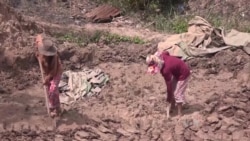On the southern outskirts of Cambodia’s capital, a ramshackle factory turns out tens of thousands of bricks each month. Pale rows of freshly fired bricks wait for buyers under the corrugated iron roof, while a 50-meter-long oven leaks a dull heat as it bakes a new batch.
These bricks are the product of hours of labor by 10 workers, among them 46-year-old Chrup and her daughter Pheap. This is the only work that Chrup, who began working at a brick factory in 1979 at the age of 11, has ever known.
Pheap started here last year, at age 14. That was illegal, but hardly surprising: the laws against child labor are widely ignored in places like this, and the family’s circumstances leave them little choice.
“Working here helps my mother provide for the family, otherwise she can’t earn enough,” said the softly spoken Pheap, who managed two years of sporadic schooling. “It also helps to support my siblings.”
Chrup’s husband, a former soldier, is too ill to work, so the money Chrup and her daughter earn – around $80 each for eight hours work, seven days a week – is vital to support him, a 10-year-old daughter and an infant son.
Thousands Working in 'Worst Forms of Child Labor'
Pheap’s situation is common in Cambodia, where an estimated 430,000 youth under the age of 18 work. Many are forced to quit school to help their families. Around 220,000 are employed in conditions that the International Labor Organization categorizes as the “worst forms of child labor”, including agriculture, salt production, domestic work, fishing and brick-making.
Veng Heang, who heads the Department of Child Labor, notes that the number of children working has dropped significantly from an estimated 755,000 in 1999. The government aims to halve that within a year to 375,000 children.
Targeting specific areas like agriculture and fisheries, where tens of thousands of children work, has helped: the statistic for children working in agriculture has declined from 72 percent in 2001 to 53 percent. Looking ahead, ensuring youngsters remain longer in school will prove vital.
“Not only in 2015, but after 2015 – we have to work very carefully on quality of education, food security, and especially income generation for the poor,” he said. “That is our main theme.”
Decent work programs will help too, as will behavioral change and law enforcement, although the last is more easily done with employers than with parents, who often – like Chrup – have little alternative. In those situations, said Heang, a better solution is to assist parents to earn more.
The government’s efforts have been helped by World Vision, a non-profit organization that runs a four-year project called EXCEL, which is funded by the U.S. Department of Labor.
Imelda Ochavillo, EXCEL’s project director at World Vision in Cambodia, said the aim is to help 28,000 children either to escape from exploitative work in agriculture, fisheries and domestic service, or to prevent them from taking on those jobs in the first place. Two years in, EXCEL has helped nearly 20,000 children.
“Once we find our household targets which are labeled ‘at-risk,’ we provide direct education services to the children – be they at-risk or engaged in child labor. And it can be formal education or non-formal or vocational skills training,” she said, adding that households also get livelihood support.
More Schooling, Less Working
Child labor is usually not a significant issue with children under 12, most of whom remain in their villages and attend school, said Ochavillo.
“But as you start at the age of 12 and to 17, that’s where child labor really comes in,” she said, adding that, although attitudes towards the practice are improving, more is needed.
“If you want to reduce it significantly, we should have very comprehensive interventions that would include continuous poverty alleviation, provision of alternative sources of income, decent employment for youth – and education should be made accessible,” she said.
Back at the factory, Pheap dreams of a job in a garment factory where she could earn twice what she makes here. Chrup wants more for her daughter too. After three decades of backbreaking labor, she knows this trade holds little promise.
“I don’t want her working in a brick factory forever,” said Chrup, as her husband drinks beer in their on-site shack. “I’ve worked in one my whole life, and don’t want her repeating that. If she works elsewhere she can build a better future.”
But a better future for her family looks unlikely, not least because Pheap doesn’t know how to apply for garment factory work. Meantime, the local school won’t enroll Pheap’s sister on the grounds that families employed at brick factories are transient. Poverty and a lack of opportunity mean it’s more likely the youngster will one day join her mother and sister in turning out thousands of bricks a month.









